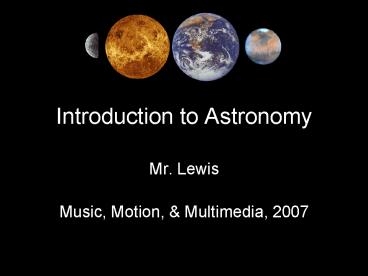Introduction to Astronomy - PowerPoint PPT Presentation
1 / 30
Title:
Introduction to Astronomy
Description:
One of Jupiter's moons, Europa may have a deep ocean of liquid water on it and ... 'Jupiter has a total of sixty-three moons, ranging from tiny 'moonlets' only a ... – PowerPoint PPT presentation
Number of Views:115
Avg rating:3.0/5.0
Title: Introduction to Astronomy
1
Introduction to Astronomy
- Mr. Lewis
- Music, Motion, Multimedia, 2007
2
Observatory
- observatory a place or building that uses large
telescopes for observing outer space.
3
Planetarium
- planetarium a domed room in which shows the
night sky from any locations at any time far in
the past to far in the future. Some planetariums
are able to show all dome films surrounding the
audience with the action.
4
Galaxy
- galaxy a very large cluster of stars (tens of
millions to trillions of stars) gravitationally
bound together.
NGC 5866 is tilted nearly edge-on to Earth's
line-of-sight.
Andromeda Galaxy, M31
5
Nebula
- nebula an enormous cloud of gas and dust.
Eagle Nebula
6
Asteroid
- asteroid boulder to mountain-sized piece of rock
remaining from the early solar system. The
largest asteroid is only 1000 kilometers across
but most are much smaller.
Asteroid 951 Gaspra
7
Milky Way Galaxy
- Milky Way Galaxy the large spiral galaxy in
which our Sun and planets reside. Our Sun is one
star of several hundred billion in the Milky Way.
8
Sun
- Sun the star at the center of our solar system.
9
Mercury
- Mercury the closest planet to the Sun.
10
Venus
- Venus the second planet from the Sun.
Venuss atmosphere is composed mostly of
carbon dioxide. There are several layers of
clouds many kilometers thick composed of sulfuric
acid. Its pressure is 90 times that of earth.
Some areas of the planet are so hot that they
would cause lead to melt. Source
www.nineplanets.org.
11
Earth
- Earth the third planet from the Sun.
12
Rotate
- rotate when an object spins
13
Revolve
- revolve when an object moves in a circular-like
pattern (orbits) another object.
14
Orbit
- orbit the path one object takes around another
object.
15
Our Moon
- Moon a rocky sphere that orbits the Earth.
Most rocks on the surface of the Moon seem to be
between 4.6 and 3 billion years old. Source
www.nineplanets.org.
16
Craters
- craters a hole in the ground made by the impact
of a meteorite.
Meteor Crater in Arizona, 49,000 years old.
Aristarchus and Herodotus on the moon
17
Greenhouse Effect
- greenhouse effect the trapping of heat energy
close to a planet's surface by certain types of
gases in the atmosphere (e.g., water, methane,
and carbon dioxide). These gases allow visible
light from the Sun to reach the surface but
prevent the infrared light from the heated
surface to radiate back to space.
18
Mars
- Mars fourth planet from the sun.
Mars once had liquid water on it and therefore,
possibly life. It may still have liquid water and
life on it below the surface.
19
Valles Marineris
- Valles Marineris a huge canyon. It is found on
Mars.
20
Olympus Mons
- Olympus Mons the largest mountain in the solar
system. This mountain is a volcano and found on
Mars.
Almost as big as the state of Arizona
21
Jupiter
- Jupiter the fifth planet from the Sun.
22
Europa
- One of Jupiters moons, Europa may have a deep
ocean of liquid water on it and therefore may
have life in the ocean.
Jupiter has a total of sixty-three moons,
ranging from tiny "moonlets" only a few miles in
diameter up to giant Ganymede, which is larger
than two of the planets in the solar system. The
four largest moons are called the Galilean moons
because they were discovered by Galileo Galilei
when he started using his primitive telescope
almost five hundred years ago. Source Astronomy
for Kids at http//www.dustbunny.com/afk/planets/j
upiter/jupmoons.html
23
Great Red Spot
- Great Red Spot a giant hurricane like storm that
is about 2 times bigger than the size of Earth.
24
Saturn
- Saturn the sixth planet from the Sun.
25
Uranus
- Uranus the seventh planet from the Sun.
26
Neptune
- Neptune the eighth planet from the Sun.
27
Pluto
- Pluto Pluto was officially re-classified from a
full-fledged planet to a "dwarf planet" on August
24, 2006. That means Pluto is no longer
considered a real planet. Consequently, our
solar system now has only eight planets.
Charon
28
Questions to Ponder
- How is it possible that Earth and other planets
do not crash into each other? - Why does the moon appear so cratered and Earth
does not? - Is it possible for an asteroid to hit Earth?
- What causes the seasons on Earth?
- How does the sun create energy?
- Is there life on other planets?
29
Questions to Ponder
- Are humans responsible for the greenhouse effect?
- Should Pluto be reclassified as a real planet?
- What causes gravity?
- How fast is our solar system traveling through
space? - Is it possible to create a situation on the moon
that allows life to exist?
30
Questions to Ponder
- Are the dangers involved in space travel actually
worth the knowledge that humans gather when they
go in space? - How is it possible for a gas planet to remain a
gas planet? Gas tends to go its on way on
Earth. - Since light travels, does that mean that if a
star explodes and it is 2 million light years
from Earth, did the star actually explode 2
million years ago?

